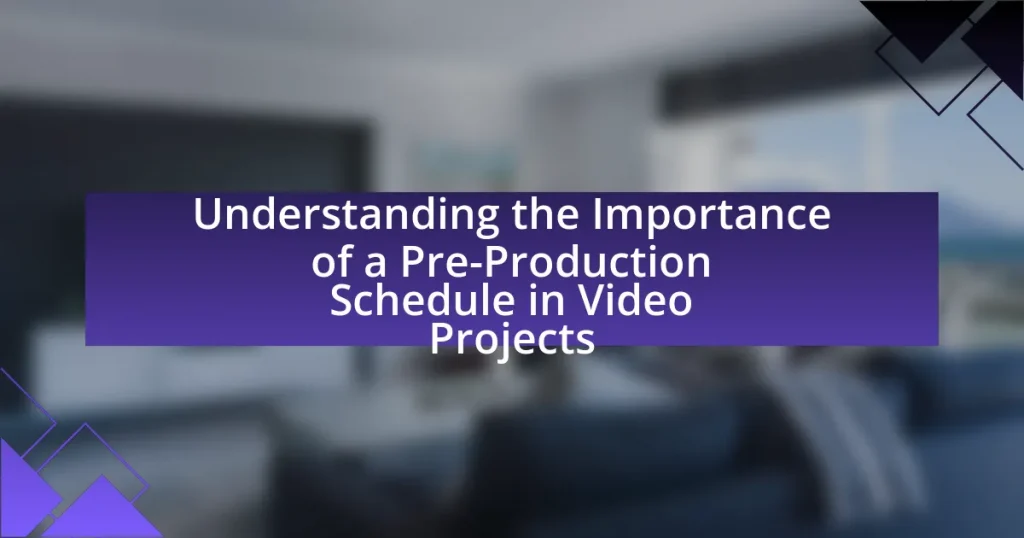Budgeting for pre-production is a critical process that involves estimating and allocating financial resources for activities prior to the actual production of a film or media project. This article outlines the importance of accurate budgeting, highlighting key components such as personnel costs, location expenses, and equipment rentals. It also addresses common challenges faced during budgeting, strategies to mitigate these challenges, and best practices for creating an effective budget. Additionally, the article emphasizes the significance of prioritizing expenses, maintaining transparency, and regularly reviewing budgets to ensure financial integrity and project success.

What is Budgeting for Pre-Production?
Budgeting for pre-production is the process of estimating and allocating financial resources for all activities that occur before the actual production of a film, television show, or other media project. This budgeting phase includes costs related to script development, casting, location scouting, equipment rental, and hiring crew members. Accurate budgeting is crucial as it helps ensure that the project stays within financial limits and can be completed successfully. According to the Producers Guild of America, a well-structured pre-production budget can significantly reduce the risk of overspending and project delays.
Why is budgeting essential in the pre-production phase?
Budgeting is essential in the pre-production phase because it establishes a financial framework that guides the entire production process. A well-defined budget allows producers to allocate resources effectively, ensuring that all necessary elements, such as cast, crew, locations, and equipment, are adequately funded. According to a study by the Producers Guild of America, projects with detailed budgets are 30% more likely to stay on schedule and within financial limits, highlighting the importance of budgeting in minimizing financial risks and maximizing production efficiency.
What are the key components of a pre-production budget?
The key components of a pre-production budget include personnel costs, location expenses, equipment rentals, production design, and contingency funds. Personnel costs cover salaries for cast and crew, while location expenses encompass permits and site fees. Equipment rentals involve costs for cameras, lighting, and sound gear. Production design includes expenses for sets, costumes, and props. Contingency funds are allocated for unexpected costs, typically around 10% of the total budget. These components ensure comprehensive financial planning for a successful production.
How does a well-structured budget impact the overall production process?
A well-structured budget significantly enhances the overall production process by providing clear financial guidelines that facilitate resource allocation and cost management. This clarity allows production teams to prioritize essential tasks, ensuring that critical resources are available when needed, which minimizes delays and inefficiencies. For instance, a study by the Project Management Institute found that projects with well-defined budgets are 20% more likely to be completed on time and within scope, demonstrating the direct correlation between budgeting and production efficiency.
What are the common challenges faced in pre-production budgeting?
Common challenges faced in pre-production budgeting include inaccurate cost estimates, unforeseen expenses, and resource allocation issues. Inaccurate cost estimates often arise from a lack of detailed planning or experience, leading to budget overruns. Unforeseen expenses can occur due to changes in project scope, weather conditions, or equipment failures, which can significantly impact the budget. Resource allocation issues may stem from miscommunication among team members or unclear project timelines, resulting in inefficient use of funds. These challenges can hinder the overall success of a production if not addressed effectively.
How can unexpected costs affect the pre-production budget?
Unexpected costs can significantly disrupt the pre-production budget by leading to financial shortfalls and reallocations of funds. When unforeseen expenses arise, such as equipment failures or last-minute location changes, they can consume resources that were originally allocated for other essential aspects of production. This can result in delays, reduced quality of production elements, or the need to seek additional funding, which may not always be available. Historical data from film industry reports indicate that projects often exceed their budgets by 20% to 30% due to such unexpected costs, underscoring the importance of contingency planning in pre-production budgeting.
What strategies can be employed to mitigate budgeting challenges?
To mitigate budgeting challenges, organizations can implement strategies such as detailed planning, regular monitoring, and contingency budgeting. Detailed planning involves creating a comprehensive budget that outlines all expected costs, which helps in identifying potential financial pitfalls early. Regular monitoring of expenditures against the budget allows for timely adjustments, ensuring that overspending is addressed promptly. Contingency budgeting, which allocates a percentage of the budget for unexpected expenses, provides a financial buffer that can absorb unforeseen costs. These strategies are supported by research indicating that organizations with robust budgeting practices experience fewer financial discrepancies and improved project outcomes.

How do you create an effective pre-production budget?
To create an effective pre-production budget, begin by clearly defining all potential costs associated with the project, including personnel, equipment, locations, and permits. This comprehensive approach ensures that all necessary expenses are accounted for, which is crucial for accurate financial planning. According to the Producers Guild of America, a detailed budget can help identify funding needs and prevent overspending, as it allows for better allocation of resources and contingency planning. By itemizing each cost and regularly reviewing the budget against actual expenditures, filmmakers can maintain financial control throughout the production process.
What steps should be taken to develop a pre-production budget?
To develop a pre-production budget, the first step is to outline all potential costs associated with the project. This includes expenses for personnel, equipment, locations, permits, and other logistical needs. Next, categorize these costs into fixed and variable expenses to better understand financial requirements. Following this, research and gather quotes from vendors and service providers to ensure accurate pricing. Additionally, create a contingency fund, typically 10-20% of the total budget, to account for unforeseen expenses. Finally, review and revise the budget regularly throughout the pre-production phase to accommodate any changes or new information. This structured approach ensures comprehensive financial planning and resource allocation for the project.
How do you estimate costs accurately for various production elements?
To estimate costs accurately for various production elements, one must conduct a detailed analysis of each component involved in the production process. This involves breaking down the production into specific elements such as cast, crew, locations, equipment, and post-production services, and then researching the market rates for each element. For instance, industry standards indicate that hiring a professional crew can range from $500 to $2,000 per day depending on their expertise and the project’s scale. Additionally, utilizing historical data from similar past productions can provide a reliable benchmark for estimating costs. By combining current market research with historical data, one can create a comprehensive budget that reflects realistic expenses, thereby enhancing the accuracy of cost estimations.
What tools and resources can assist in budgeting for pre-production?
Tools and resources that assist in budgeting for pre-production include budgeting software, spreadsheets, and industry-specific templates. Budgeting software like Movie Magic Budgeting and Celtx provides comprehensive features for tracking expenses and generating reports, which are essential for accurate financial planning. Spreadsheets, such as Microsoft Excel or Google Sheets, allow for customizable budgeting formats and easy collaboration among team members. Additionally, industry-specific templates available online can streamline the budgeting process by providing pre-formatted categories and expense tracking methods, ensuring that all necessary costs are accounted for. These tools enhance efficiency and accuracy in pre-production budgeting, which is critical for project success.
How can you prioritize expenses in your pre-production budget?
To prioritize expenses in your pre-production budget, first categorize all potential expenses into essential and non-essential items. Essential expenses include costs that are critical for the project’s success, such as cast salaries, location fees, and equipment rentals, while non-essential expenses may include promotional materials or luxury accommodations.
Next, assess the impact of each expense on the overall production quality and timeline. For instance, investing in experienced crew members can enhance production value, making it a higher priority.
Finally, allocate funds based on these assessments, ensuring that essential expenses are fully funded before considering non-essential items. This method aligns with industry practices, where prioritizing critical elements can lead to more efficient budget management and successful project outcomes.
What criteria should be used to determine essential versus non-essential expenses?
Essential expenses are those necessary for the basic functioning and success of a project, while non-essential expenses are discretionary and can be adjusted or eliminated without jeopardizing the project’s core objectives. To determine essential versus non-essential expenses, consider criteria such as necessity for project completion, impact on quality and outcomes, contractual obligations, and alignment with strategic goals. For instance, costs related to equipment rental or key personnel salaries are typically essential, whereas luxury accommodations or optional marketing materials may be classified as non-essential. This classification helps prioritize spending and ensures that resources are allocated effectively to meet project demands.
How can prioritization affect the overall production timeline?
Prioritization directly influences the overall production timeline by determining which tasks and resources are allocated first, thereby streamlining workflow and reducing delays. When critical tasks are prioritized, teams can focus on essential elements that drive the project forward, ensuring that deadlines are met efficiently. For instance, a study by the Project Management Institute indicates that projects with clearly defined priorities are 20% more likely to be completed on time compared to those without. This demonstrates that effective prioritization not only enhances productivity but also minimizes the risk of bottlenecks in the production process.

What best practices should be followed for pre-production budgeting?
Best practices for pre-production budgeting include creating a detailed budget breakdown, involving all key stakeholders, and allowing for contingency funds. A detailed budget breakdown ensures that every aspect of production, from cast and crew salaries to equipment rentals and location fees, is accounted for, which helps in avoiding unexpected costs. Involving key stakeholders, such as producers, directors, and department heads, fosters collaboration and ensures that all necessary expenses are considered. Allocating contingency funds, typically around 10-15% of the total budget, prepares the production for unforeseen expenses, which is crucial as many productions encounter unexpected costs. These practices are supported by industry standards, which emphasize thorough planning and financial foresight as essential components of successful film and television production.
How can you ensure transparency and accountability in budgeting?
To ensure transparency and accountability in budgeting, implement a structured process that includes clear documentation, regular audits, and stakeholder involvement. Clear documentation allows all budgetary decisions and allocations to be recorded, making it easier to track expenditures and justify financial choices. Regular audits, whether internal or external, provide an objective review of budget adherence and financial practices, ensuring compliance with established guidelines. Involving stakeholders, such as team members and financial officers, fosters open communication and collective responsibility, which enhances trust and accountability in the budgeting process. These practices are supported by studies indicating that organizations with transparent budgeting processes experience improved financial performance and stakeholder satisfaction.
What role does communication play in maintaining budget integrity?
Communication is essential for maintaining budget integrity as it ensures transparency and accountability among all stakeholders involved in the budgeting process. Effective communication facilitates the sharing of financial information, clarifies expectations, and allows for timely adjustments to budgetary allocations. For instance, regular updates and discussions among team members can prevent misunderstandings that may lead to overspending or misallocation of resources. Research indicates that organizations with strong communication practices experience a 25% increase in budget adherence, highlighting the direct correlation between communication and budget integrity.
How can regular budget reviews enhance financial management?
Regular budget reviews enhance financial management by ensuring that spending aligns with financial goals and identifying variances early. These reviews allow organizations to adjust their budgets based on actual performance, which can lead to more informed decision-making. For instance, a study by the Association for Financial Professionals found that organizations conducting regular budget reviews are 30% more likely to meet their financial targets compared to those that do not. This proactive approach helps in reallocating resources effectively, minimizing waste, and optimizing overall financial performance.
What are some tips for staying on budget during pre-production?
To stay on budget during pre-production, create a detailed budget plan that outlines all expected costs. This plan should include categories such as location fees, equipment rentals, and personnel expenses. By breaking down the budget into specific line items, you can identify potential overspending areas early on. Additionally, regularly review and adjust the budget as needed to reflect any changes in production plans or unexpected expenses. Historical data shows that productions with a well-defined budget plan are 30% more likely to stay within their financial limits, highlighting the importance of thorough financial planning.
How can contingency planning help manage unforeseen expenses?
Contingency planning helps manage unforeseen expenses by allocating a specific budget reserve to address unexpected costs. This proactive approach ensures that funds are available when unanticipated financial demands arise, reducing the impact on overall project budgets. For instance, industry standards suggest setting aside 5-10% of the total budget for contingencies, which can effectively cover emergencies without derailing the project timeline or objectives. By anticipating potential risks and preparing financial resources in advance, organizations can maintain financial stability and project continuity even in the face of unexpected challenges.
What are the benefits of tracking expenses in real-time?
Tracking expenses in real-time enhances financial awareness and control, allowing individuals or organizations to make informed decisions promptly. This immediate visibility into spending patterns helps identify areas where costs can be reduced, ultimately leading to better budget management. According to a study by the American Psychological Association, individuals who track their expenses regularly report feeling more in control of their finances, which can reduce stress and improve overall financial health. Additionally, real-time tracking can prevent overspending by alerting users to budget limits as they approach them, fostering more disciplined financial behavior.
What common pitfalls should be avoided in pre-production budgeting?
Common pitfalls to avoid in pre-production budgeting include underestimating costs, failing to account for contingencies, and neglecting to involve key stakeholders in the budgeting process. Underestimating costs can lead to insufficient funds, as many projects experience unexpected expenses that exceed initial estimates. For instance, a study by the Producers Guild of America found that 70% of film budgets exceed their original projections due to overlooked expenses. Failing to account for contingencies can result in financial strain when unforeseen issues arise, making it essential to allocate a percentage of the budget for unexpected costs. Additionally, neglecting to involve key stakeholders, such as department heads, can lead to misaligned expectations and budget discrepancies, as their insights are crucial for accurate budgeting.
How can overestimating or underestimating costs impact the project?
Overestimating or underestimating costs can significantly impact a project’s success by affecting resource allocation, stakeholder trust, and overall project viability. When costs are overestimated, projects may secure excessive funding, leading to inefficient use of resources and potential budget cuts in other areas. Conversely, underestimating costs can result in budget shortfalls, causing delays, reduced quality, or project failure. A study by the Project Management Institute found that 43% of projects experience cost overruns, highlighting the critical importance of accurate budgeting in maintaining project integrity and stakeholder confidence.
What are the consequences of neglecting to update the budget regularly?
Neglecting to update the budget regularly can lead to significant financial discrepancies and project overruns. When a budget is not updated, it fails to reflect current expenses, income, and unforeseen costs, resulting in inaccurate financial planning. This can cause overspending, as teams may rely on outdated figures, leading to resource misallocation. Additionally, stakeholders may lose confidence in the project’s financial management, which can jeopardize funding and support. According to a study by the Project Management Institute, 70% of projects fail due to poor budgeting and financial oversight, highlighting the critical need for regular budget updates to ensure project success and financial stability.



